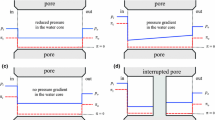Summary
The pressure-dependence of the hydraulic conductivity and of electrical membrane parameters inValonia utricularis are determined over a turgor pressure range of 4 to 4.5 atm by means of a direct measurement of the hydrostatic pressure inside the cell. The dependence of the hydraulic conductivity on pressure is calculated from the volume flows and subsequent changes in the turgor induced by both osmotic and hydrostatic gradients.L p is independent of pressure above 1 atm and equal under osmotic and hydrostatic conditions. Polarity of water movement is not observed. At pressures below 1 atm,L p increases up to 10 times on approaching the point of plasmolysis. This increase is discussed in terms of membrane folding and of the stretching of pores within the membrane. In contrast to this finding the membrane resistance (normally 300 to 500 Ω cm2) increases markedly in response to higher pressures and reaches a maximum value of 1500 Ω cm2 at about 2 atm. Further increase of the hydrostatic pressure reduces the membrane resistance again until the original value is reached at 3 to 4 atm. In the range of the maximum resistance the membrane potential (0 to +15 mV at 1 atm) drops by 10 to 40 mV. At low pressures the membrane potential drops in the dark, while at high pressures and reduced membrane potential an increase of the p.d. is observed. From these results it is suggested that the electrogenic potassium pump postulated by Gutknecht is pressure-dependent and causes the observed changes in membrane resistance. According to this hypothesis, with increasing pressure the potassium influx would be reduced and the potassium efflux accelerated. This means that the electrogenic pump reverses its direction at high pressures.
Similar content being viewed by others
References
Barry, P. H. 1970. Volume flows and pressure changes during an action potential in cells ofChara australis. II. Theoretical considerations.J. Membrane Biol. 3:335
Barry, P. H., Hope, A. B. 1969. Electroosmosis in Membranes: Effects of unstirred layers and transport numbers, Part I. Theory.Biophys. J. 9:700
Barry, P. H., Hope, A. B. 1969. Electroosmosis in Membranes: Effects of unstirred layers and transport numbers, Part II. Experimental.Biophys. J. 9:729
Ben-Amotz, A., Avron, M. 1973. The role of glycerol in the osmotic regulation of the halophilic algaDunaliella parva.Plant Physiol. 51:875
Burton, A. C. 1970. The stretching of pores in a membrane.In: Permeability and Function of Biological Membranes. L. Bolis, A. Katschalsky, R. D. Keynes, W. R. Loewenstein, and B. A. Pethica, editors. Part I, p. 1. North-Holland Publishing Company, Amsterdam and London
Dainty, J. 1969. The water relations of plants.In: The Physiology of Plant Growth and Development. M. B. Wilkins, editor. p. 421. MacGraw-Hill, London
Fensom, D. S., Dainty, J. 1963. Electroosmosis inNitella.Canad. J. Bot. 41:685
Fensom, D. S., Wanless, J. R. 1967. Further studies of electroosmosis inNitella in relation to pores in membranes.J. Exp. Bot. 18:563
Frenkel, S. Y. A., Kukhareva, L. V., Ginzburg, B. M., Gaspanyan, K. A., Vorobev, Y. J. 1965. Effect on load on the order-disorder transition in native collagen fibres.Biofizika 10:735
Guillard, R. R. L. 1962. Salt and osmotic balance.In: Physiology and Biochemistry of Algae. R. A. Lewin, editor. p. 529. Academic Press Inc., New York, Amsterdam
Gutknecht, J. 1966. Sodium, potassium and chloride transport and membrane potentials inValonia ventricosa.Biol. Bull., Woods Hole. 130:331
Gutknecht, J. 1967. Ion fluxes and short-circuit current in internally perfused cells ofValonia ventricosa.J. Gen. Physiol. 50:1821
Gutknecht, J. 1967. Membranes ofValonia ventricosa: Apparent absence of water-filled pores.Science 158:787
Gutknecht, J. 1968. Salt transport inValonia: Inhibition of potassium uptake by small hydrostatic pressure.Science 160:68
Katchalsky, A., Curran, P. F. 1965. Nonequilibrium Thermodynamics in Biophysics. Harvard University Press, Cambridge, Mass.
Kauss, H. 1969. Osmoregulation mit α-Galaktosylglyzeriden bei Ochromonas und Rotalgen.Ber. Dtsch. Bot. Ges. 82:115
Kedem, O., Katchalsky, A. 1958. Thermodynamic analysis of the permeability of biological membranes to nonelectrolytes.Biochim. Biophys. Acta 27:229
Kesseler, H. 1964. Die Bedeutung einiger anorganischer Komponenten des Seewassers für die Turgorregulation vonChaetomorpha linum (Cladophorales).Helgoländer Wiss. Meeresunters. 10:73
Philip, J. R. 1958. The osmotic cell, solute diffusibility, and the plant water economy.Plant Physiol. 33:264
Richardson, I. W., Ličko, V., Bartoli, E. 1973. The nature of passive flows through tightly folded membranes.J. Membrane Biol. 11:293
Schobert, B., Untner, K., Kauss, H. 1972. Isofloridosid und die Osmoregulation bei Ochromonas malhamensis.Z. Pflanzenphysiol. 67:385
Stadelmann, E. 1966. Evaluation of turgidity, plasmolysis and deplasmolysis of plant cells.In: Methods in Cell Physiology. D. M. Prescott, editor. Vol. II, p. 143. Academic Press Inc., New York and London
Steudle, E., Zimmermann, U. 1971. Hydraulische Leitfähigkeit vonValonia utricularis.Z. Naturf. 26:1302
Steudle, E., Zimmermann, U. 1971. Zellturgor und selektiver Ionentransport beiChaetomorpha linum.Z. Naturf. 26b:1276
Steudle, E., Zimmermann, U. 1974. Determination of the hydraulic conductivity and of reflection coefficients inNitella flexilis by means of direct cell-turgor pressure measurements.Biochim. Biophys. Acta 332:399
Teorell, T. 1951. Zur quantitativen Behandlung der Membranpermeabilität.Z. Elektrochem. 55:460
Zimmermann, U., Raede, H., Steudle, E. 1969. Kontinuierliche Druckmessung in Pflanzenzellen.Naturwissenschaften 56:634
Zimmermann, U., Steudle, E. 1970. Bestimmung von Reflexionskoeffizienten an der Membran der AlgeValonia utricularis.Z. Naturf. 25b:500
Zimmermann, U., Steudle, E. 1971. Effects of potassium concentration and osmotic pressure of sea water on the cell-turgor pressure ofChaetomorpha linum.Marine Biol. 11:132
Author information
Authors and Affiliations
Rights and permissions
About this article
Cite this article
Zimmermann, U., Steudle, E. The pressure-dependence of the hydraulic conductivity, the membrane resistance and membrane potential during turgor pressure regulation inValonia utricularis . J. Membrain Biol. 16, 331–352 (1974). https://doi.org/10.1007/BF01872422
Received:
Issue Date:
DOI: https://doi.org/10.1007/BF01872422




